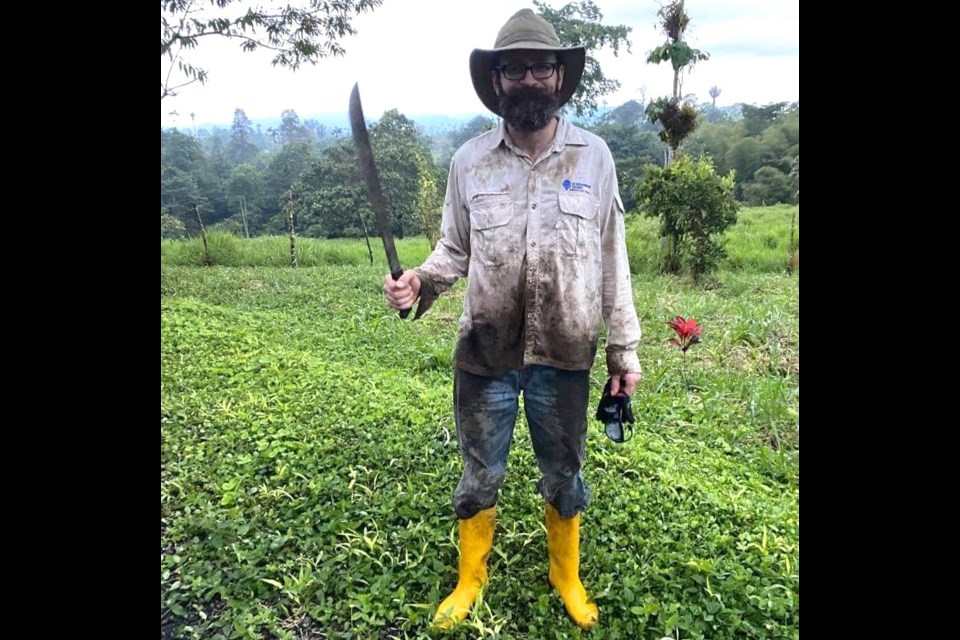MOOSE JAW — It’s not every day you hear about a Saskatchewan chocolate farmer wielding a machete and farming cacao in the Ecuadorian cloud forest — but that’s just a typical winter routine for Robert Payant.
A fourth-generation farmer from Assiniboia, Sask., Payant splits his year between harvesting grain on his family’s prairie farm and cultivating ancestral Nacional cacao in Ģ����Ƶ����Ƶ America, alongside his wife and business partner Tiffany Rose. The couple’s venture, Choco Estates, bridges two worlds — industrial agriculture in Saskatchewan and biodiversity-rich agroforestry in one of the most ecologically important regions on Earth.
“In the summer, Robert’s out running combines with his brother and dad,” Rose said. “Come winter, he’s in Ecuador, covered in dirt, swinging a machete and planting cacao under banana trees.”
The Payants are part of a growing cooperative that’s rewilding degraded pastureland in Ecuador’s Chocó Andino — a United Nations Educational, Scientific and Cultural Organization (UNESCO) protected cloud forest that’s home to an extraordinary diversity of life. The region is also one of the last bastions of Nacional cacao, a nearly extinct, aromatic variety of cacao renowned for its fruity and floral notes.
An earlier visit to a friend’s farm in Ecuador inspired the Payants to found Choco Estates, which now includes three neighbouring farms in the country and is founded on the principles of justice and sustainability.
“Robert and I bought our land in 2019 after visiting friends who had started a similar project,” Rose recalled. “It was all degraded cow pasture — just grass and clay. Now, it’s a food forest.”
The transformation of land once degraded by disease and monoculture into soil that’s alive and rich is slow and deliberate. First come pioneer species like cassava and banana to break up the compacted clay soil and provide canopy cover. Only then is cacao planted beneath, alongside fruit trees, cardamom, and native timber species planted by the couple.
“It mimics how the forest would grow naturally,” Rose explained. “It’s the opposite of how big chocolate companies do it.”
Their approach is more than just sustainable — it’s regenerative. By using agroforestry techniques and reviving the ancestral Nacional cacao, the couple is helping to preserve biodiversity while supporting local Ecuadorian farmers with year-round employment and living wages.
“Chocolate has become so industrialized,” Rose said, adding that industrial practices have reduced this variety to less than five per cent of Ecuador’s chocolate production. “Prices are driven down, and farmers are pushed out. We’re trying to show that there’s another way.”
While the bulk of their chocolate is crafted and consumed in Ecuador, the Payants are bringing a taste of their tropical harvest home to the Prairies.
“I brought 50 pounds back in my suitcase this year,” Rose said with a smile. “We have bars at 70, 75, and 83 per cent dark, plus beans and couverture chocolate for chefs and bakers. Folks can contact me through our website if they want to try it.”
Despite the dramatic differences in climate and scale, the couple practices what they preach on both continents.
“Our yard in Assiniboia is completely grassless,” said Rose. “We’ve applied agroforestry principles here too — though with plants suited to the dry prairie.”
It’s a wildly unexpected path for a small-town Saskatchewan farmer, but nevertheless, it’s one that maintains close roots to the hard work and values that define life on the farm.
“At the heart of it, we’re just trying to grow something good — for the land, for the people, and for the future of chocolate,” Rose said.
Choco Estates products are not yet available in local stores, but they can be sampled by contacting Rose and Payant directly on Instagram at “” or through .
If you’re wondering whether chocolate can truly grow from prairie roots, the Payants are proving it’s more than possible: it’s delicious.




